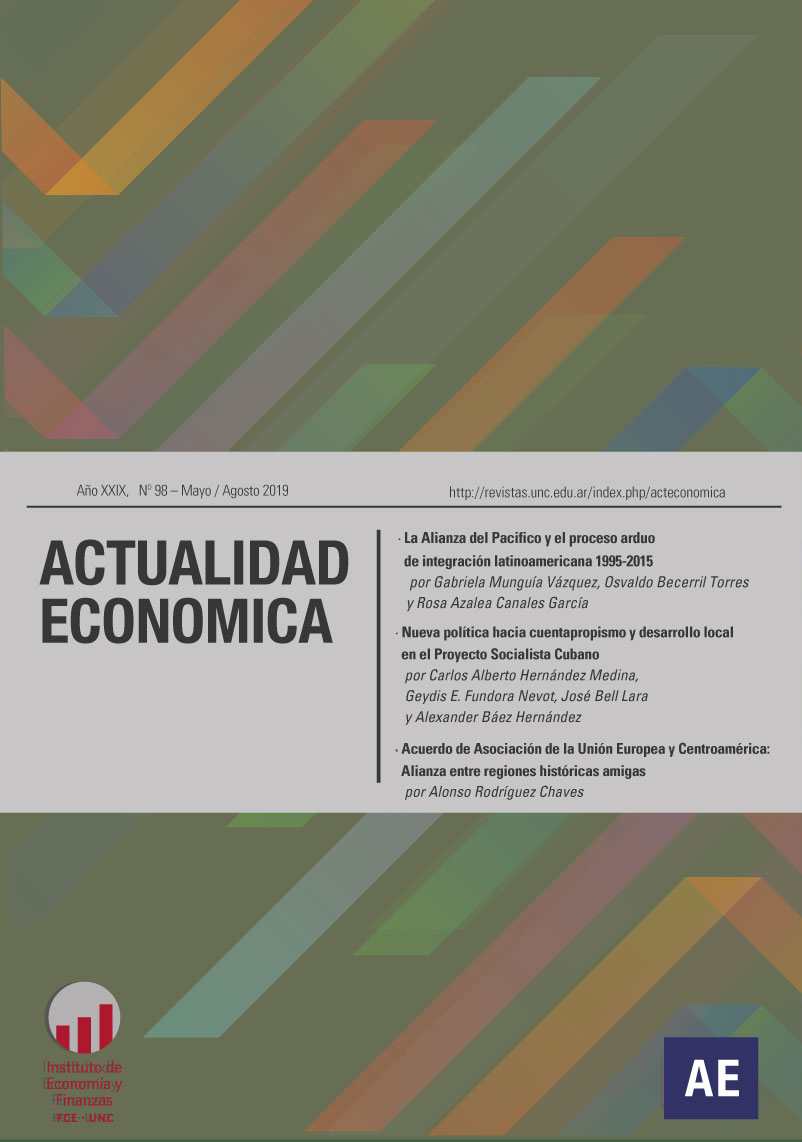Association Agreement of the European Union and Central America: Alliance between historical friendly regions
Keywords:
Central America, European Union, Association Agreement, integration, dialogue summitAbstract
The Association Agreement between the European Union and Central America seeks to deepen ties between the two regions. In particular, try to consolidate an alliance between two regions, taking into account the efforts and discussion forums have jointly undertaken in recent decades. The paper recognizes the strong affinity of values, principles, common interests and concerns, allowing despite its asymmetry, reinforce and strengthen relations between regions. Consummated, displayed significant relationships that encourage potential areas of cooperation related to the defense of the core values of freedom, democracy, human rights, rule of law, among others. Thus, the letter invites you to learn more about this instrument, which can mean an important alternative development, and that surpasses the idea of a Free Trade Agreement, and includes issues such as development cooperation, political dialogue and commercial.
Downloads
References
Barbé, E. (1995). Relaciones internacionales. Tecnos. Madrid.
Bulmer-Thomas, V. y Douglas K. (2001). Centroamérica 2020: hacia un nuevo modelo de desarrollo regional. Cuadernos de Ciencias Sociales, FLACSO, San José.
Comisión Europea. (2006) Una asociación reforzada entre la Unión Europea y América Latina. Oficina de Publicaciones Oficiales de las Comunidades Europeas. Luxemburgo.
Comunicado Conjunto. (2003). XIX Conferencia Ministerial del Diálogo de San José. Panamá. Disponible en: http://ec.europa.eu/comm/external_relations/ca/doc/19sjd_es.htm
Cuarta Cumbre Unión Europea - América Latina y Caribe. (2006). Declaración de Viena: Fortaleciendo la asociación estratégica birregional. Viena, Austria.
Cuevas, R. (coord.) (2004). Integración en Centroamérica cultural, social, política y económica. Con trabajos de Cuevas, C.; Camacho, J. y Delgado J. Universidad Nacional, Instituto de Estudios Latinoamericanos, Maestría en Estudios Latinoamericanos. Heredia, Costa Rica.
Govarei, V.; Talavera, E. y Ruiz, H. (2007). CAFTA-DR: Oportunidades y peligros. San José, Costa Rica.
Guerra, A. (1991). "Teoría de las uniones aduaneras: la nueva vertiente y Un problema epistemológico: la definición de integración". En La integración de América Latina y el Caribe: La práctica de la Teoría. México.
Guerra, A. (2002). Globalización e integración latinoamericana. México: Siglo XXI. IIE-UNAM y Universidad Rafael Landívar. México.
Hansen, F. (2008). La cooperación de la Unión Europea hacia Centroamérica: tendencias ante el nuevo milenio: Propuestas y Acciones Conjuntas - Hacia Estocolmo - RDS-HN. Disponible en: http://ns.rds.org.hn/estocolmo/caes/propuestas/conj_02/conj_02.htm
Hartmann, F. (2008). Introducción a las Relaciones Internacionales capítulos. Capítulos 1, 2 y 3. Disponible en: www.perio.unlp.edu.ar/relaciones_internacionales/realismohartmann.pdf
Hernández, J. (2005) Apuntes de Economía Internacional. Editorial e Imprenta Servicios Profesional-SERPRO. 1 edición. Guatemala.
Kardjova, E. y Versteeg, P. (2004). “Unión Europea-Centroamérica: relaciones políticas, económicas y de cooperación”. En La integración centroamericana: realidad y perspectivas. Comisión Europea.
La Unión Europea en Centroamérica. (1984). 1ra. Conferencia del proceso de San José, Costa Rica. Disponible en: www.delnic.cec.eu.int/es/eu_and_country/relations/bilateral_relations.htm
Laínez, F. (2006). Lanzamiento del Curso Virtual sobre la Relación Económica entre Centroamérica y la Unión Europea. San Salvador. Consultar en: http://www.rree.gob.sv/sitio/sitiowebrree.nsf/pages/curvirt06
Ministerio de Comercio Exterior de Costa Rica. (2006) Importancia para Costa Rica del proceso de negociación de un acuerdo de asociación con la Unión Europea. San José, Costa Rica.
Orozco, M. (2003) “Economía y desarrollo: causas potenciales de conflictos sociales. Futuro”. En Revista trimestral latinoamericana y caribeña de desarrollo sustentable. N 2, Vol 1.
Pacheco, A. (2005). “Ventajas para Costa Rica en la firma de un tratado de libre comercio con la Unión Europea”. En Estudios europeos e integración regional. Arnoldo Rubio Ríos (compilador). Universidad Nacional. Costa Rica.
Reunión de Presidentes (2007) miércoles 12 de diciembre. Documento disponible en: www.sica.int/busqueda/Informaci%C3%B3n%20Entidades.aspx?IDItem=3054&IDCat=29&IdEnt=401&Idm=1&IdmStyle=1
Rouquayrol, L y Herrero S. (2007). Guía sobre la cooperación, Unión Europea-América Latina. Editor Asociación CEFICALE ley 1901. Francia
Unidad Regional de Asistencia Técnica -RUTA (2011). "Trabajando por el desarrollo rural sostenible de Centroamérica. Siete gobiernos y siete agencias en acción. Fase 2004-2007".
Salazar, J. (2003). Las relaciones Europa con el Caribe, Centroamérica, México y Cuba Las relaciones Europa con el Caribe, Centroamérica, México. Milano, Italia. Consultar en www.sice.oas.org/Tunit/STAFF_ARTICLE/jmsx03_europa_s.asp
Santamaría, O. (2003). “La reforma del marco institucional: lecciones y desafíos". En El proceso de integración Centroamericana y el papel de la Unión Europea, publicación de la Conferencia “Integración Regional Centroamericana y la Reforma Institucional”, Bruselas, 3 de marzo de 2003. Disponible en http://www.eeas.europa.eu/ca/docs/integ_1203_es.pdf. .
Sanahuja, J. (2008). El Centro Latinoamericano para las Relaciones con Europa, (CELARE). En www.celare-alcue.org/nosotros.html
Secretaria de Integración Económica Centroamericana, SIECA. (2006). Relaciones comerciales y de cooperación entre Centroamérica y la Unión Europea. Guatemala. Disponible en www.sieca.org.gt/SIECA.htm
Sistema de la Integración Centroamericana (SICA). (2007) Reseña Histórica del SICA. Disponible en www.sica.int/sica/resena_sica.aspx?IdEnt=401
Touraine, A. (2000). ¿Qué es la democracia?. Fondo de Cultura Económica México. 2 edición.
Ulate, E. (2004). Integración regional y derecho comunitario europeo y centroamericano. Tomo I Parte General. San José.
Downloads
Published
Issue
Section
License
Those authors who have published with this journal, accept the following terms:
Authors will conserve their copyright and guarantee the magazine the right of first publication of their work, which will be simultaneously subject to the Creative Commons Attribution-NonCommercial-NoDerivative 4.0 International License that allows third parties to share the work as long as the author and first publication of this magazine are indicated.
Authors may adopt other non-exclusive license agreements to distribute the published version of the work (e.g., deposit it in an institutional telematic archive or publish it in a monographic volume) provided that the initial publication in this journal is indicated.
Authors are allowed and encouraged to disseminate their work through the Internet (e.g., in institutional telematic archives or on their website) before and during the submission process, which may lead to interesting exchanges and increase citations of the published work. (See The effect of open access)









